Israeli Strikes Impact Presence Of Hezbollah At Border

Israel has completed a series of extensive strikes against Hezbollah targets in Lebanon, attacks which have impacted the Iran-backed group's positioning near the border.

Israel has completed a series of extensive strikes against Hezbollah targets in Lebanon, attacks which have impacted the Iran-backed group's positioning near the border.
Israeli military spokesperson Rear Admiral Daniel Hagari said in a televised statement on Friday, "We continue intensive strikes to hit Hezbollah's deployment close to the northern border."
"It no longer looks as it did on October sixth, nor will it," he said about the situation on Israel's northern border with Lebanon, where Hezbollah is entrenched.
Hagari said the targets of the recent synchronized air, tank and artillery strikes included launch pads, military compounds and militant squads.
Hezbollah has been trading fire with Israel at the border since its Palestinian ally Hamas attacked Israel on October 7, igniting a conflict that has drawn in the heavily armed group and other Iran-aligned factions across the Middle East.
Iran supports Hamas but says it did not play any role in the Islamist militants' terror attack that triggered the current crisis. Tehran also denies involvement in the recent attacks on vessels in the Red Sea by Houthis, another group backed by Iran.
But the violence has largely been contained to areas at the border, shaped by what observers have called unwritten rules of engagement between adversaries that have long threatened each other with catastrophic damage in the event of war.
Israel has said it is not seeking to open a front in the north. Israeli Prime Minister Benjamin Netanyahu has warned that Beirut would be turned "into Gaza" if Hezbollah started an all-out war.
(With reporting by Reuters)

As 2023 ends, a human rights group has documented numerous cases of violations, including those targeting religious and ethnic groups, women and labor activists.
Human Rights Activists in Iran (HRA) published its annual report for 2023 on December 28, in which diverse cases of human rights violations were detailed and categorized.
Spanning January 1 to December 20, 2023, the publication is the result of the collection, analysis and documentation of 9,656 human rights reports from 111 media and legal sources.
Crackdown On Labor Activists
According to the report, at least 2,021 protest rallies were held in Iran in 2023, the majority of which were trade union and labor demonstrations, including 111 labor strikes. Security and intelligence agencies used intimidation, arrests and prosecutions to intimidate labor activists.
Over the past months, protests and strikes have continued in different sectors as the Islamic Republic grapples with growing unrest fueled by unmet demands from retirees and workers.
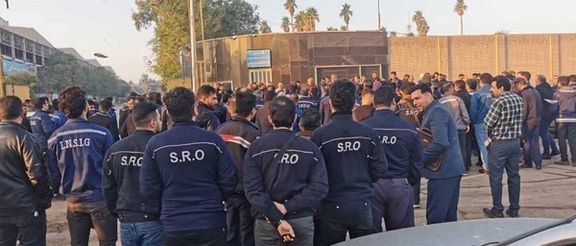
Toward the end of December, workers at the Esfahan Steel Company halted operations, conveying their discontent through organized gatherings and chanting slogans.
Amidst the labor unrest, the regime-run Statistics Center of Iran (SCI) reported a household inflation rate of 45.5%. Alarmingly, one-third of the country is experiencing inflation rates exceeding 50%, as indicated by the same report.
Ongoing Repression Of Ethnic, Religious Minorities
The HRA 2023 report also stated that 324 people were arrested over their ethnic activism, 19 of whom were given 984 months of imprisonment by the Islamic Republic’s judiciary. In comparison with 2022, the numbers show a 44-percent increase in arrests and a 31-percent increase in prison sentences given to ethnic activists in Iran.
142 people were arrested for religious reasons and a total of 5,113 months of imprisonment were handed down to members of religious monitories in Iran. The HRA went on to say, that 85 percent of the reports regarding rights violations of religious monitories concern the Baha’i community.
In November, the Court of Appeals in northern Mazandaran province sentenced 14 Baha’i citizens to imprisonment and fines.
The Baha’i faith is not recognized as a legitimate religion by Iran’s Shiite clerical regime, leading to systematic and longstanding violations of the rights of Baha’is in the country.
Approximately 300,000 Baha'is reside in Iran, and they frequently document a pattern of regular rights violations. The violations encompass harassment, forced displacement from their residences and businesses, and unequal treatment regarding government employment and access to higher education.
Regime Targets Women Activists
Women activists were also severely targeted by the Iranian government in 2023. HRW reported that 44 women were arrested for their activism for women’s rights and 3,176 were prosecuted by the government over their refusal to wear compulsory hijab.
26 cases of rape and sexual harassment and 82 cases of murdering women were also documented by HRW. The report also stipulated that the Iranian government systematically deprives LGBT and queer groups of their rights.
In September, the Iranian parliament greenlit a bill titled “Protection of Family Through Promotion of Hijab and Chastity Culture.” Initially introduced by the government and subsequently amended by hardliner lawmakers, the legislation outlined penalties, including substantial fines, for women diverging from the prescribed Islamic dress code.
Freedom Of Speech Violations & Academic Repression
Violating freedom of thought and speech, the Iranian regime arrested 3,130 people in 2023 and handed down 25,124 months of imprisonment, according to the HRA report.
Human Rights Activists in Iran also documented 3,067 cases of university students being summoned to “disciplinary committees” at their academic institutions and 23 cases of interrogations by judiciary and intelligence entities outside universities. School students were targeted by a campaign of mysterious chemical poisoning in late 2022 and early 2023. Six thousand such cases of poisonings were reported in 2023.
Many Iranians suspect the mysterious poisoning incidents that affected tens of thousands of students across the country following anti-government protests were orchestrated as revenge by the regime or the religious hardliners it protects. This was perceived as a measure to intimidate and subdue the youth involved in the protest movement. The poisonings began in Qom on November 30, 2022, spreading nationwide until April, leading to hospitalizations and at least one reported death.
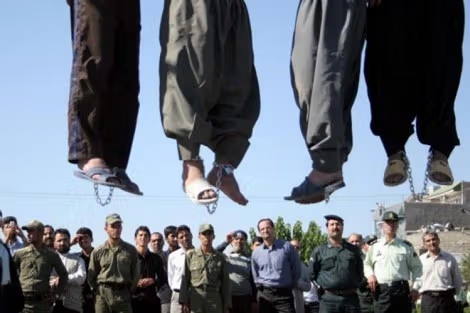
The Islamic Republic’s Juggernaut of Executions
HRA also noted that 746 people were executed in Iran in 2023, with 6 being executed in public, with 56 percent of the executions carried out over drug-related crimes and 35 percent over murder.
The United Nations, the European Union, and human right activists and groups have repeatedly voiced concern over the Islamic Republic’s execution juggernaut and its near-record killing spree in 2023.
In October, UN Secretary-General Antonio Guterres highlighted a surge in executions in Iran in a report submitted to the 78th session of the General Assembly.
A comparison with HRW’s 2022 report it becomes apparent that the Islamic Republic has intensified its crackdown against religious, ethnic and gender minorities, and also political and labor activists in 2023.
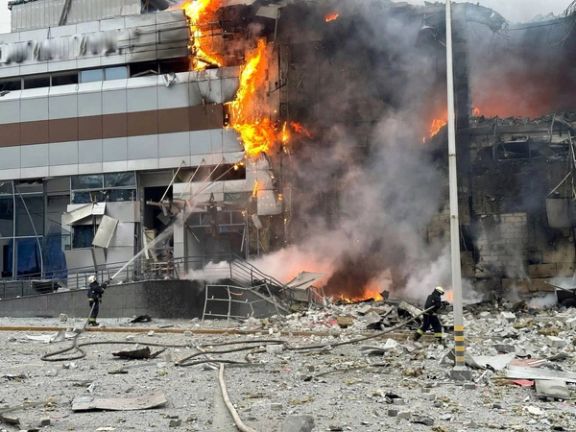
Russia launched 122 missiles and 36 drones against Ukrainian targets, killing at least 13 civilians in what was described as the biggest barrage of the 22-month war.
Ukraine’s military chief, Valerii Zaluzhnyi, said Friday that the Ukrainian air force intercepted 87 of the ballistic and cruise missiles and 27 of the Shahed-type drones overnight. The aerial attack that began Thursday and continued through the night, hitting six cities, including the capital, Kyiv, and other areas from east to west and north to south Ukraine.
Air Force commander Mykola Oleshchuk wrote on his official Telegram channel that it was “the most massive aerial attack” since Russia’s full-scale invasion in February 2022.
At least 88 people were injured and an unknown number were buried under rubble during the roughly 18-hour onslaught, Ukrainian officials said. Among the buildings reported to be damaged across Ukraine were a maternity hospital, apartment blocks and schools.

Ukrainian President Volodymyr Zelenskyy said on X, “Today, Russia used nearly every type of weapon in its arsenal.”
Air Force spokesperson Yurii Ihnat said on air that an attack of this scale "has not been seen for a long time." According to the Ukrainian air force, the previous biggest assault was in November 2022 when Russia launched 96 missiles against Ukraine.
Western officials and analysts have recently warned that Russia had limited its cruise missile strikes in recent months in an apparent effort to build up stockpiles for massive strikes during the winter.
Iran has supplied hundreds of the kamikaze Unmanned Aerial Vehicles (UAV) to Russia since mid-2022, which Moscow has used extensively to target civilian infrastructure and cities.
The drones are also used during massive missile attacks to overwhelm Ukrainian air defenses. The drones are relatively cheap, costing around $20,000 each and Ukraine sometimes has to fire much more expensive anti-air missiles to bring them down.
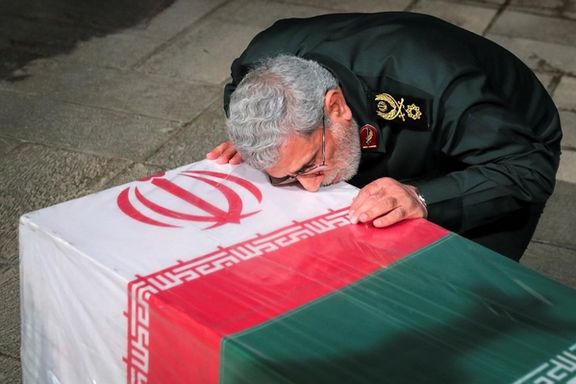
Saudi and Israeli media reported Friday that 11 senior officers of Iran’s Revolutionary Guards were killed in the Thursday Israeli air strike on Damascus airport.
According to Al Arabiya sources, the targeted IRGC members, responsible for overseeing Iran-backed forces in eastern Syria, were at the airport to welcome a senior delegation. IRGC spokesman Ramezan Sharif denied the report on Friday without providing any details.
One of the IRGC commanders in Syria, Major General Gholam-Ali Rashid Ali-Nour, was also injured in the airstrike, Saudi media channel Al-Hadath reported.
The attack near the airport came "one whole day after the airport resumed flights," said the British-based monitor the Syrian Observatory for Human Rights.
Israel rarely comments on strikes targeting Syria, but it keeps reiterating that it will not allow its nemesis Iran to entrench itself in the country. Israel has been regularly attacking targets in Syria since 2017 to weaken Iran's attempts to strengthen its military presence in the war-torn country and build up a threat on Israel's northern borders. In the past year, Syrian airports have become frequent targets, as Iran is reportedly shipping weapons for its proxy forces by planes.
Earlier this week, the IRGC confirmed that one of its top commanders in Syria, Brig. Gen. Razi Mousavi, was killed in an Israeli “missile attack.”
Iranian President Ebrahim Raisi and several other military commanders have issued messages, warning that Israel “will certainly pay for this crime.”

Iran announced this week that it exported $26.5 billion of oil during the past 9 months, a figure that contradicts both previous Iranian and international estimates.
For years, Iranian administrations have not transparently disclosed their oil revenues, citing the illicit nature of shipments under the US sanctions regime. However, in the past two months, the Raisi government has released some statistics on oil revenues, labeling it the 'transparency of the Raisi administration.
Mohammad Rezvani-Far, the Head of Iran Customs Administration (IRICA), stated on December 27, that during the first 9 months of current Iranian fiscal year, the country's oil exports totaled $26.46 billion, electricity exports were $300 million, and technical and engineering services exports were approximately $780 million.
He referred to the total foreign trade of the country during this period as $112 billion, stating that $63 billions of this amount is related to the total exports of the country, including oil, electricity, and services.
At the same time, Ehsan Khandouzi, the Minister of Economic Affairs and Finance, also confirmed these figures.
Confirmation comes while the figures presented by Minster Khandouzi and the Head of the Central Bank of Iran last month indicated that the total exports of oil, electricity, and services of the country in the first 8 months of the current fiscal year (March 2023 to November 2023) were about $20 billion.
From the official statements of the Raisi administration, it is understood that the average monthly exports of oil, electricity, and services in the first 8 months were $2.5 billion, but suddenly in the 9th month of the Iranian calendar, it surged to over $7.5 billion.
Statistics from industry monitoring firm Kpler show that the volume of Iran's oil exports in the past month not only did not grow compared to previous months but it showed a notable decrease.
Also, tanker tracking companies' statistics show that Iran exports 1.25 million barrels per day of crude oil and gas condensate as well as more than 200 thousand barrels of petroleum products (mazut and kerosene) during the current fiscal year.
The nominal price of Iranian oil is between $80-$85 according to OPEC statistics. Thus, Iran's oil export revenues should have been about $34 billion in the nine-month perios, but the statements of the Head of Customs and the Minister of Economy indicate that this figure is $26.46 billion.
The reason for this lies in Iran's extensive discounts to Chinese oil refineries and the cost of circumventing sanctions, especially middlemen, who arrange the illicit Iranian shipments to China by various methods, including mixing Iranian crude with shipments from other countries, thus hiding their origin.
Iran also barters some of its oil with Chinese goods. However, this amount is included in the country's oil export figures.
The Customs statistics in China show that from April to November (approximately the first 9 months of the Iranian calendar year), China imported about $2.6 billion of non-oil goods and $5.5 billion of exports to Iran. Thus, about $3 billion of Iran's oil exports to China during this period were spent on bartering with Chinese goods.
In the process of bartering oil with goods, a significant part of the value of Iran's oil is wasted due to the costs of dealers and intermediaries.
Service Exports And The Country's Trade Balance
UN statistics show that in 2017, before the US imposed sanctions, Iran had nearly $10 billion in annual service exports, the majority of which was transportation, personal travel, construction services as well as business travel. Iran's service imports were $17 billion as well.
The latest statistics from the Iran Trade Development Organization show that the country's service exports reached just $2.3 billion in 2021, and some scattered statements by Iranian officials indicate that this figure was about $4 billion last year. Now, the statements of the head of Iran Customs show that in the first 9 months of this year, this figure has dropped to $780 million. He did not explain why the country's export of services suddenly plummeted.
The Central Bank of Iran does not separately publish statistics on the export and import of services, but it publishes the statistics of the trade balance of services (the difference between service exports and imports), which has always been around negative five to six billion dollars in recent years.
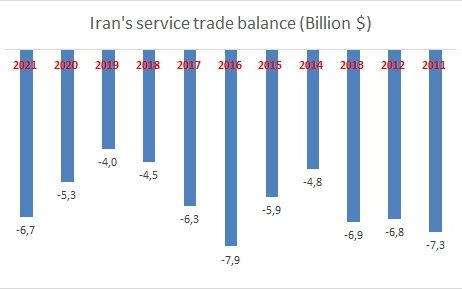
The head of customs and the minister of economy, without mentioning the existence of the annual negative balance of five to six billion dollars for services, only referred to the statistics of service exports, oil, and non-oil goods and claimed that during the 9 months, the total foreign trade balance of the country was a positive $15 billion.
In other words, in the calculations of these senior officials, Iran had a total of $63 billion in oil, non-oil, and service exports during this period, but only imported $49 billion in goods. The figures presented by the two senior officials of Ebrahim Raisi administration only include the import of goods and do not include petroleum products imports (gasoline), as well as service imports, and it cannot be claimed that the foreign trade balance was a positive $15 billion during this period.
Capital Flight
Central Bank statistics show that, considering oil, non-oil and service trade, Iran's net capital account was a negative $15 billion last Iranian year (March 2022-March 2023). In other words, the outflow of foreign currencies from the country was $15 billion more than the inflow of foreign currencies.
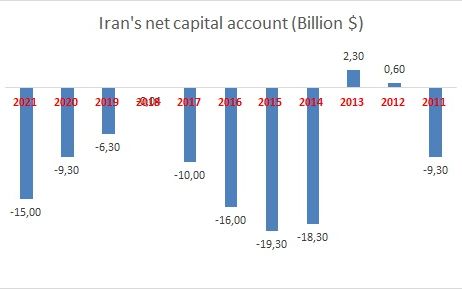
Central Bank statistics show that the country had about $100 billion negative capital account during 2011-2021.
Part of this situation is due to the large gap in the balance of trade in services, but a significant part of it is also due to the efforts of the people to take their capital out of Iran and buy property in foreign countries, especially Turkey, the Emirates, and Western countries.
Reports from the Turkish Statistical Institute show that in recent years, Iranian have been the top buyers of homes in this country. Since the US imposed sanctions against Iran in 2018, Iranians have purchased about 39,000 homes in Turkey.
The purchase of houses and properties is just one facet of capital flight from Iran. Owing to the unfavorable economic prospects within the country, Iranian citizens have embarked on substantial capital investments, diversifying into various forms of real estate and assets abroad.

Former Israeli Prime Minister Naftali Bennett has called for Israel and the US to confront Iran directly, ‘making it pay’ for sowing chaos through its proxy militias.
In an op-ed published by the Wall Street Journal Thursday, Bennett, who was prime minister from June 2021 to June 2022, admitted that Israel was behind attacking an Iranian base and the assassination of a senior IRGC commander in 2022.
Calling on Israel and the US to topple the Iranian regime, he described the Islamic Republic as “the source of endless war, terror and suffering throughout the world.” He called it inexplicable that almost nobody is taking on Tehran, which has been “at the center of most of the Middle East’s problems and much of global terror.”
Israel rarely admits publicly to attacking Iran directly, but Bennett wrote, "After Iran launched two failed UAV attacks on Israel in February 2022, Israel destroyed a UAV base on Iranian soil. In March 2022, Iran’s terror unit attempted to kill Israeli tourists in Turkey and failed. Shortly thereafter, the commander of that very unit was assassinated in the center of Tehran."
Hassan Sayyad-Khodaei, a member of IRGC’ Quds Force, was the deputy commander of Unit 840 and in charge of its operations in the Middle East and countries neighboring Iran.
On December 25, a senior IRGC commander, Razi (Reza) Mousavi, was killed by an alleged Israeli airstrike in Syria, for which Iranian officials have threatened that Israel would pay a high price.
"The US and Israel must set the clear goal of bringing down Iran’s evil regime. Not only is this possible. It is vital for the safety and security of the Middle East—and the entire civilized world," Bennett concluded in his piece.